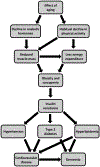Hormonal and Metabolic Changes of Aging and the Influence of Lifestyle Modifications
- PMID: 33673927
- PMCID: PMC8020896
- DOI: 10.1016/j.mayocp.2020.07.033
Hormonal and Metabolic Changes of Aging and the Influence of Lifestyle Modifications
Abstract
Increased life expectancy combined with the aging baby boomer generation has resulted in an unprecedented global expansion of the elderly population. The growing population of older adults and increased rate of age-related chronic illness has caused a substantial socioeconomic burden. The gradual and progressive age-related decline in hormone production and action has a detrimental impact on human health by increasing risk for chronic disease and reducing life span. This article reviews the age-related decline in hormone production, as well as age-related biochemical and body composition changes that reduce the bioavailability and actions of some hormones. The impact of hormonal changes on various chronic conditions including frailty, diabetes, cardiovascular disease, and dementia are also discussed. Hormone replacement therapy has been attempted in many clinical trials to reverse and/or prevent the hormonal decline in aging to combat the progression of age-related diseases. Unfortunately, hormone replacement therapy is not a panacea, as it often results in various adverse events that outweigh its potential health benefits. Therefore, except in some specific individual cases, hormone replacement is not recommended. Rather, positive lifestyle modifications such as regular aerobic and resistance exercise programs and/or healthy calorically restricted diet can favorably affect endocrine and metabolic functions and act as countermeasures to various age-related diseases. We provide a critical review of the available data and offer recommendations that hopefully will form the groundwork for physicians/scientists to develop and optimize new endocrine-targeted therapies and lifestyle modifications that can better address age-related decline in heath.
Copyright © 2020 Mayo Foundation for Medical Education and Research. Published by Elsevier Inc. All rights reserved.
Figures


References
-
- Ortman JM, Velkoff VA, Hogan H. An aging nation: the older population in the United States: United States Census Bureau, Economics and Statistics Administration, US; 2014.
-
- Roberts AW, Ogunwole SU, Blakeslee L, Rabe MA. The population 65 years and older in the United States: 2016: US Department of Commerce, Economics and Statistics Administration, US; 2018.
-
- Olshansky SJ. From lifespan to healthspan. Jama. 2018;320:1323–1324. - PubMed
-
- Lamberts SW, Van den Beld AW, Van Der Lely A-J. The endocrinology of aging. Science. 1997;278:419–424. - PubMed
-
- Greendale GA, Lee NP, Arriola ER. The menopause. The Lancet. 1999;353:571–580. - PubMed
Publication types
MeSH terms
Grants and funding
LinkOut - more resources
Full Text Sources
Other Literature Sources
Medical

